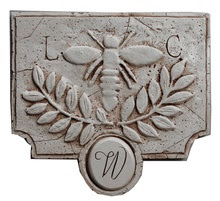This past summer while sitting in the backyard, I started remembering how when I was young, the clover flowers were always covered with bees. I can't tell you how many times I was stung on the feet or toes because I loved to go barefoot. As I sat there I started looking for bees. I only counted five as far as I could see surrounding me. I knew there was a problem because I have see the numbers decrease over the past few years, but it really disturbed and saddened me that I may be watching the extinction of a species.
This is my tribute to the bee, and being a design blog, it will of course focus on how to decorate your interiors with them. Enjoy, and I hope you get some ideas!!
Napoleon chose the bee as his personal symbol.There are several theories of how this came about. One interesting theory is when he overthrew the French government and took up residence in the Royal Palace at Tuileries, he refused to spend money on new decor. However, he could not allow the curtains - with their embroidered fleur-de-lis, (the French Royal emblem), to continue to hang in the windows of the palace. His solution was to have the rich and elegant velvet drapes turned upside down. The inverted symbol of the overthrown monarchy looked like a bee.
Interesting honeycomb patterned door.
There are beautiful bee inspired accessories in home decor stores that will add a touch of "french" to your home.
A gorgeous antique embroidered piece with the bee symbol next to a crown. (perhaps from the court of Napoleon)
Bee skeps are a popular design element. They are wonderful when used in outside garden areas.
Skeps are pretty to use as table decorations.
Vintage honey jars shaped like skeps.
Bee skeps can even be used in interiors as chandeliers.
Take a moment to watch this young man play Rimsky-Korsakov's Flight of the Bumblebee. It is INCREDIBLE!
There is a variety of bee themed fabrics on the market today that are gorgeous when used to upholster furniture.........
or use as window treatments.
Lovely antique dish!
I collect miniature French Limoges porcelain boxes so this hand painted bee one caught my eye.
Beeswax... a wonderful product we can thank bees for!
The color of beeswax comprising a comb is at first white and then darkens with age and use. This is especially true if it is used to raise brood. Pigmentation in the wax can result in colors ranging from white, through shades of yellow, orange, and red all the way to brown.
Bees even show up in jewelry!
Incredible bee embellished antique dress!
A BIG thank you to the bees for this yummy treat!!
Don't forget bee inspired craft projects!
Vintage art.
Old honey tins are great for a county style interior.
Increasingly each spring, beekeepers open their hives to find entire colonies wiped out. But beekeepers aren't the only ones who are worried - bees pollinate at least a third of the world's crops. If the dramatic decline in worldwide bee populations continues, essential food crops could disappear, along with entire ecosystems. The Strange Disappearance of the Bees is a frightening expose (and one we should all see) on the massive deaths of bees recently sweeping the world. Bringing together the latest scientific research, this documentary explores the constellation of factors causing dramatic colony collapses in beehives around the world. If they go in sufficient numbers.......
Increasingly each spring, beekeepers open their hives to find entire colonies wiped out. But beekeepers aren't the only ones who are worried - bees pollinate at least a third of the world's crops. If the dramatic decline in worldwide bee populations continues, essential food crops could disappear, along with entire ecosystems. The Strange Disappearance of the Bees is a frightening expose (and one we should all see) on the massive deaths of bees recently sweeping the world. Bringing together the latest scientific research, this documentary explores the constellation of factors causing dramatic colony collapses in beehives around the world. If they go in sufficient numbers.......




































